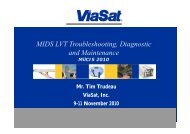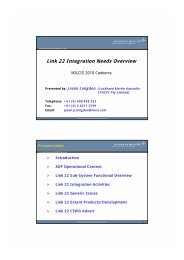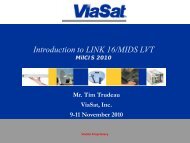Monitoring Link 16 Networks for Compliance with National ... - MilCIS
Monitoring Link 16 Networks for Compliance with National ... - MilCIS
Monitoring Link 16 Networks for Compliance with National ... - MilCIS
You also want an ePaper? Increase the reach of your titles
YUMPU automatically turns print PDFs into web optimized ePapers that Google loves.
<strong>Monitoring</strong> <strong>Link</strong> <strong>16</strong> <strong>Networks</strong><br />
<strong>for</strong> <strong>Compliance</strong> <strong>with</strong> <strong>National</strong><br />
Frequency Clearance<br />
Agreements
Agenda<br />
Frequency Usage Background<br />
Australian Frequency Clearance<br />
Agreement<br />
<strong>Monitoring</strong> Challenges<br />
Implementation Approaches<br />
ViaSat Brings Your Network To Life
Frequency Allocations<br />
The use of the band 960-1215 MHz by the<br />
aeronautical radionavigation service is<br />
reserved on a worldwide basis <strong>for</strong> the<br />
operation and development of airborne<br />
electronic aids to air navigation and any<br />
directly associated ground-based facilities.<br />
960 – 1<strong>16</strong>4 MHz<br />
Aeronautical Mobile (R) 5.327A<br />
Aeronautical RadioNavigation 5.328<br />
1<strong>16</strong>4 – 1215 MHz<br />
Aeronautical RadioNavigation 5.328<br />
Radionavigation-Satellite 5.328B<br />
ViaSat Brings Your Network To Life
<strong>Link</strong> <strong>16</strong> Frequency Usage<br />
960<br />
14 FREQs<br />
IFF IFF<br />
1030<br />
1090 1215<br />
51 TOTAL CENTER FREQUENCIES SPACED AT 3 MHz INTERVALS<br />
Spread Spectrum<br />
5 FREQs 32 FREQs<br />
Frequency Hopping – 51 Frequencies<br />
Rate: 1/13 msec or 76,923 hops per second<br />
Frequency not held constant<br />
IFF NOTCHES (2)<br />
Centered on 1030 & 1090 MHz<br />
ViaSat Brings Your Network To Life
<strong>Link</strong> <strong>16</strong> Radio Limitations<br />
§ 87.479<br />
stations.<br />
Harmful interference to radionavigation land<br />
Military or other Government stations have been authorized to<br />
establish wide-band systems using frequency-hopping spread<br />
spectrum techniques in the 960–1215 MHz band. Authorization<br />
<strong>for</strong> a Joint Tactical In<strong>for</strong>mation Distribution Systems (JTIDS) has<br />
been permitted on the basis of non-interference to the<br />
established aeronautical radionavigation service in this band. In<br />
order to accommodate the requirements <strong>for</strong> the system <strong>with</strong>in<br />
the band, restrictions are imposed. Transmissions will be<br />
automatically prevented if:<br />
(1) The frequency-hopping mode fails to distribute the JTIDS<br />
spectrum uni<strong>for</strong>mly across the band;<br />
(2) The radiated pulse varies from the specified width of 6.4<br />
microseconds ±5%;<br />
(3) The energy radiated <strong>with</strong>in ±7 MHz of 1030 and 1090 MHz<br />
exceeds a level of 60 dB below the peak of the JTIDS spectrum<br />
as measured in a 300 kHz bandwidth. The JTIDS will be<br />
prohibited from transmitting if the time slot duty factor exceeds<br />
a 20 percent duty factor <strong>for</strong> any single user and a 40 percent<br />
composite duty factor <strong>for</strong> all JTIDS emitters in a geographic<br />
area.<br />
ViaSat Brings Your Network To Life
The Time Slot<br />
<strong>Link</strong> <strong>16</strong> uses the<br />
principle of Time<br />
Division Multiple<br />
Access (TDMA)<br />
Each JU is assigned a<br />
set of “time slots” in<br />
which to transmit<br />
their data<br />
Contains: Jitter,<br />
Synchronization, Time<br />
Refinement,<br />
Message Header,<br />
Data, Propagation<br />
Jitter & Propagation:<br />
“Dead Times”<br />
Message In<strong>for</strong>mation<br />
<br />
(no pulses Jitter<br />
transmitted)<br />
Pulses: Encoded <strong>with</strong><br />
Sync Header Data 1<br />
258 Pulses<br />
Data 2 Propagation<br />
in<strong>for</strong>mation<br />
444 Pulses<br />
ViaSat Brings Your Network To Life<br />
<strong>Link</strong> <strong>16</strong><br />
7.8125 msec<br />
Time Slot
<strong>Link</strong> <strong>16</strong> Time Intervals<br />
1 Day = 24 hours<br />
1 Day = 112.5 Epochs<br />
1 Epoch = 12.8 min<br />
1 Epoch = 64 Frames<br />
1 Epoch = 98k Timeslots<br />
1 Frame = 12 seconds<br />
1 Frame = 1,536 Timeslots<br />
(3 sets of 512)<br />
1 Timeslot = 7.8125 msec<br />
ViaSat Brings Your Network To Life
Time Slot Duty Factor<br />
TSDF is a percentage value representation<br />
of the number of <strong>Link</strong> <strong>16</strong> pulses in a 12<br />
second frame<br />
100% TSDF = 396,288 pulses in a frame<br />
100% TSDF is one STD Pack or P2DP<br />
Transmission (258 pulses) in every slot in<br />
a frame<br />
8 Units<br />
~5% TSDF<br />
ViaSat Brings Your Network To Life<br />
1 Unit<br />
50% TSDF
Australian Frequency<br />
Clearance Agreement<br />
Between The Commonwealth<br />
of Australia (Department of<br />
Defence) and Airservices<br />
Australia<br />
Applies to all airspace <strong>with</strong>in<br />
the Australian Flight<br />
In<strong>for</strong>mation Region<br />
Applies to all <strong>Link</strong> <strong>16</strong><br />
operations <strong>with</strong>in sovereign<br />
Australian airspace<br />
ViaSat Brings Your Network To Life<br />
http://www.airservicesaustralia.com/aboutus/howatcworks/ourairspace.asp
FCA Transmission Limitations<br />
Multiple Voice Nets Permitted<br />
Contention Access Allowed<br />
Time Slot Reallocation Permitted<br />
Up to 3 separate networks in a single<br />
geographic area<br />
200 Watt Maximum Transmit Power<br />
Packed 2 Double Pulse and Packed 4<br />
(444 pulse slots) Permitted<br />
Combat Mode is Prohibited<br />
50% TSDF Maximum For Any One Radio<br />
(applies to closely grouped radios too)<br />
Planned TSDF must be used <strong>for</strong><br />
geographic area (volume) analysis if a<br />
monitoring system is not available<br />
ViaSat Brings Your Network To Life
“Planned” TSDF<br />
Worst case TSDF based on network<br />
design<br />
Assumes a radio is transmitting in every<br />
available transmission slot<br />
Typical per participant values<br />
Fighter: ~9% (~60% <strong>with</strong> relay active)<br />
C2: ~12%<br />
Ship: ~9%<br />
Ground Station: ~5%<br />
Voice nets – 12.55% per net in use<br />
ViaSat Brings Your Network To Life
Required NAVAID Separation<br />
DME/TACAN<br />
< 50% TSDF <strong>with</strong>in 0.5 NM (926 m)<br />
< 20% TSDF <strong>with</strong>in 0.18 NM (333 m)<br />
< 1% TSDF allowed <strong>with</strong>in 300 feet (92<br />
m)<br />
Some specific NAVAIDS have more<br />
stringent restrictions (no<br />
transmissions <strong>with</strong>in 2 nm)<br />
ViaSat Brings Your Network To Life
Geographic Area Definition<br />
100 nm (185 km) Cylinder<br />
Extends from the ground to the<br />
altitude of the highest <strong>Link</strong> <strong>16</strong><br />
transmitter<br />
Centered on ‘any’ point –<br />
maximum allowed TSDF is 150%<br />
Maximum TSDF <strong>for</strong> any one radio<br />
is 50% (applies to closely spaced<br />
radios too)<br />
ViaSat Brings Your Network To Life
TSDF Volumes<br />
Planned TSDF – 183%<br />
Observed TSDF – <strong>16</strong>.4%<br />
Planned TSDF – 350%<br />
Planned TSDF – 410%<br />
Observed TSDF – 25.5%<br />
Observed TSDF – 32.2%<br />
ViaSat Brings Your Network To Life<br />
200 nm<br />
radius<br />
Centered<br />
around each<br />
transmitter<br />
Maximum of<br />
400% TSDF
TSDF Volumes<br />
Planned TSDF – 173%<br />
Observed TSDF – 8.4%<br />
Planned TSDF – 127%<br />
Observed TSDF – 9.2%<br />
ViaSat Brings Your Network To Life<br />
100 nm<br />
radius<br />
Centered<br />
around any<br />
point – best<br />
fit algorithms<br />
Maximum of<br />
150% TSDF
<strong>Monitoring</strong> Challenges<br />
Simultaneous Transmissions<br />
Multiple Relay Plat<strong>for</strong>ms<br />
Stacked Voice Nets<br />
Multiple Control and Fighter to Fighter Channels<br />
Contention Access<br />
Improper Radio Initialization<br />
Line of Sight Limitations<br />
Position Accuracy of all Transmitters<br />
Overlapping <strong>Networks</strong><br />
ViaSat Brings Your Network To Life
Approaches to FCA<br />
<strong>Monitoring</strong><br />
Multiple ground terminals to <strong>for</strong>m the<br />
backbone of the network and<br />
simultaneously monitor its compliance<br />
Modify <strong>Link</strong> <strong>16</strong> radios to self report<br />
transmission usage<br />
Single point monitoring tool <strong>with</strong><br />
delayed synchronization capability<br />
Non-JTIDS/MIDS radio frequency<br />
monitoring system (pulse counter)<br />
ViaSat Brings Your Network To Life
FCA <strong>Monitoring</strong> – Multiple<br />
Terminals<br />
Use multiple ground terminals to <strong>for</strong>m<br />
the backbone of the network and<br />
simultaneously monitor its compliance<br />
Using multiple terminals allows the detection of<br />
additional transmissions in the Slot Reuse case.<br />
Each monitoring terminal is capable of listening on<br />
a separate net <strong>for</strong> a given timeslot.<br />
If the monitoring terminals are geographically<br />
separated, each terminal could also detect a<br />
different relay plat<strong>for</strong>m in the flood relay and<br />
contention access cases (not all relay plat<strong>for</strong>ms will<br />
necessarily be detected). The more terminals used,<br />
the more transmitters that can be detected.<br />
The ground based terminals can be used<br />
simultaneously <strong>for</strong> exchange of tactical data.<br />
ViaSat Brings Your Network To Life
FCA <strong>Monitoring</strong> – Self Reporting<br />
Terminals<br />
There are currently several active discussions regarding<br />
modifications to the MIDS terminal software <strong>for</strong> each radio<br />
to periodically report the number of pulses transmitted in a<br />
given time period.<br />
Advantages<br />
Each radio would be able to account <strong>for</strong> all usage including voice and<br />
stacked nets<br />
Disadvantages<br />
Implementation timeline – MIDS and JTIDS software changes, regression<br />
testing and subsequent field upgrades to the installed plat<strong>for</strong>m base<br />
Cost (see implementation timeline)<br />
<strong>Monitoring</strong> system upgrades – either a new monitoring system would<br />
need to be fielded or upgrades implemented to existing system to<br />
process the reports generated by each radio<br />
Increased TSDF – the reports would need to be transmitted, including<br />
possible relay of transmission usage reports<br />
Network design impacts<br />
Possible host system updates to process own terminal TSDF reports and<br />
send to monitoring units and/or stations<br />
ViaSat Brings Your Network To Life
FCA <strong>Monitoring</strong> – Single Point<br />
<strong>with</strong> Delayed Synchronization<br />
Use an LVT-2/11 or ANGR-43 radio <strong>with</strong><br />
a delayed synchronization capable host<br />
to detect other transmissions<br />
The delayed synchronization capability of the LVT-2<br />
can be used to systemically determine the number<br />
of active relay plat<strong>for</strong>ms. With knowledge of the<br />
network design, duty factor <strong>for</strong> the relaying<br />
plat<strong>for</strong>ms could be calculated based on a sampling<br />
of observations.<br />
There are some line of sight assumptions that<br />
enter into the assumption of what transmissions a<br />
given relay plat<strong>for</strong>m is actually retransmitting.<br />
How and if the fielded products realize this is not<br />
known to us, but in theory it is possible<br />
ViaSat Brings Your Network To Life
FCA <strong>Monitoring</strong> –<br />
Pulse Counter<br />
Use a non-<strong>Link</strong> <strong>16</strong> radio frequency<br />
monitoring system<br />
The non-<strong>Link</strong> <strong>16</strong> systems, basically RF pulse<br />
counters, are capable of counting all <strong>Link</strong> <strong>16</strong><br />
transmissions.<br />
There may be some capability based on the<br />
number of receivers in the system to associate<br />
transmissions to a given unit if the system is<br />
integrated <strong>with</strong> an active tactical system.<br />
This is an adjunct system to <strong>Link</strong> <strong>16</strong> and does<br />
not leverage the data inside the <strong>Link</strong> <strong>16</strong><br />
messages.<br />
ViaSat Brings Your Network To Life
Leveraging the PPLI<br />
Reported position<br />
Self reported quality values<br />
Time Quality (TQ)<br />
Horizontal Position Quality (PQ)<br />
Vertical Quality (VQ) – Altitude Quality<br />
(AQ) or Elevation Quality (EQ)<br />
Active relay indicator<br />
Voice net<br />
Control channel<br />
ViaSat Brings Your Network To Life
Evaluating Reported Position<br />
Time Quality directly<br />
impacts reported<br />
position accuracy<br />
ViaSat Brings Your Network To Life
Improperly Configured<br />
Ground Station<br />
ViaSat Brings Your Network To Life
QUESTIONS?<br />
Jon Stearn<br />
Jon.Stearn@viasat.com<br />
+1.760.795.6312






